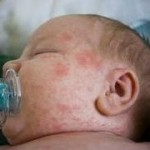Most Common Food Allergies in Children
 Allergies are of different types. There are some things which our body cannot tolerate. The reaction of the body when that particular thing is consumed or one gets in touch with it is called an allergic reaction, and the person is called allergic to that particular thing. There is a difference between food allergies and food intolerance though some of the symptoms of these are common. As such they are often confused and considered interchangeable.
Allergies are of different types. There are some things which our body cannot tolerate. The reaction of the body when that particular thing is consumed or one gets in touch with it is called an allergic reaction, and the person is called allergic to that particular thing. There is a difference between food allergies and food intolerance though some of the symptoms of these are common. As such they are often confused and considered interchangeable.
Food intolerance could result in development of gas, burps, indigestion and loose stool, headache and nervousness which is common between the two i.e. food intolerance and food allergies but food intolerance will never result in affecting the immune system. A common instance of food intolerance is intolerance of the body to lactose. A lactose intolerant child will immediately show signs of sickness when he or she drinks milk or substance containing milk.
Food allergies are more common in children and the effect of these items goes on reducing as the child grows up. As per a survey, about 6% of children below the age of 3 are allergic to some or the other item of food and the instances are quite less in adults.
Generally the items to which the children are allergic are milk, eggs, peanuts, nuts or fish. 80% of the children who are allergic to milk or egg or soya will outgrow them by the time they are of five years of age. However, in respect of allergies caused due to other food items, they rarely get over it with age. Some types of food allergies start to appear as a person grows up. A child may not be allergic to fish but when he grows up into an adult he may develop an allergic reaction to fish. In case of some people who are allergic to some items of food, the reaction may be milder as compared to the other set of people. Some may get reaction on one part of the body while in case of others several organs may get affected.
Symptoms
Those children who get severely affected by food allergies can develop one or more of the following symptoms when they eat or come in contact with the item to which they are allergic:
- In case the skin is affected the child may develop red bumps on the skin and may feel intense itching. The face may the most affected part of the body in case skin is affected. The face of the child may get swollen and he may feel swelling or intense itching on the lips, tongue and mouth.
- Many children report problem with their gastrointestinal tract. There is acute pain in the abdomen associated with abdominal cramps. The child may suffer from nausea, vomiting and diarrhoea.
- Respiratory tract is also adversely affected in the case of many children. This results in a wheezing sound coming from the wind pipe of the child when he breathes. This can be accompanied with running or stuffy nose, sneezing and coughing. The child may feel breathless. This state of child needs immediate medical attention.
- In more serious cases the cardiovascular system may get affected. The child may faint and the condition could be fatal.
The most serious type of allergic reaction from an item of food is called anaphylaxis. This has adverse reaction on many parts of the body and could be life threatening. The common symptoms are excessive swelling inside airways, resulting in breathing problem. The blood pressure of the patient falls and the child could get unconscious. It may result in death if immediate medical facility is not made available.
Diagnosis and Treatment
When you will take your child for treatment of allergic reaction, the doctor will like to know the history of the allergic reaction of the family as a whole. Frequency of allergic reaction, time between eating particular food and appearance of reaction etc. He may like to get some test conducted to ascertain about the alleged allergic reactions.
First of all testing for food allergies in children is done by the doctors by the skin test. Liquid extract of the item of food to which the child is allergic is placed on the back of the child and the effect is noticed by the doctor. If the skin turns red in about 15 minutes it is certain that the child is allergic. There are some more specialised tests done on the child once the initial test is positive. These are to ascertain the effect of a particular medicine. In certain cases a particular item of food to which a child is allergic is given under strict medical supervision in increasing doses.
Though, no medicines are generally prescribed for a particular type of allergy the child is advised to keep away from that item of food. An effort should be made to ensure that the child does not eat that item even in precooked or pre packed food. To reduce the discomfort, some anti allergic medicines are given to the child. Slowly, as the child grows older, the reaction will decrease and the child will be normal and able to eat whatever he wants.